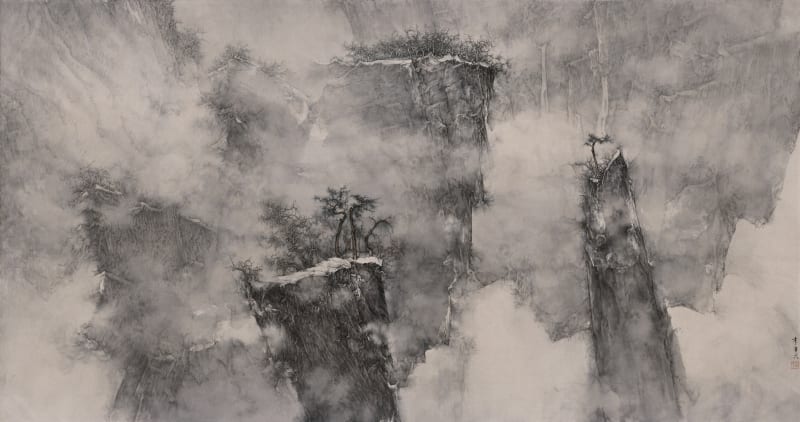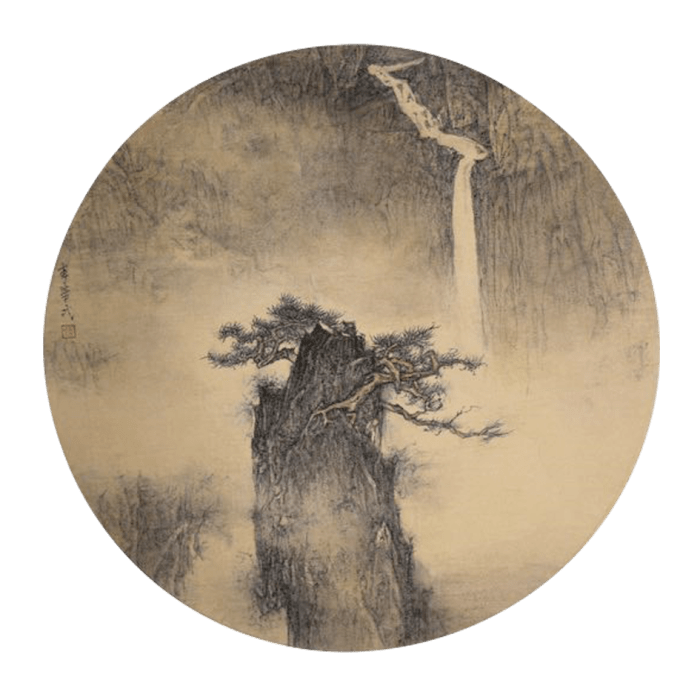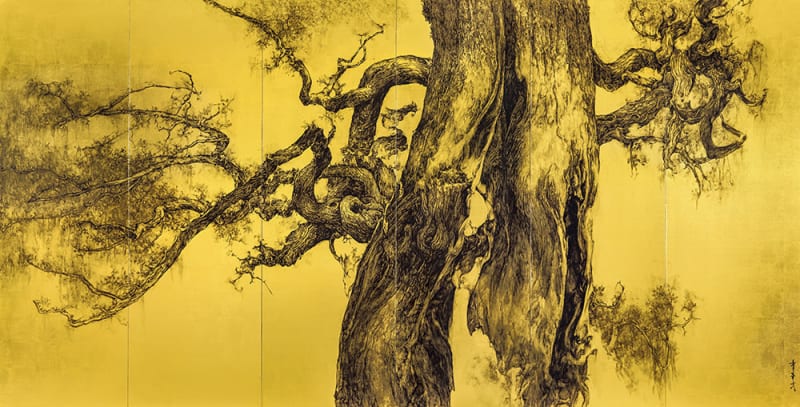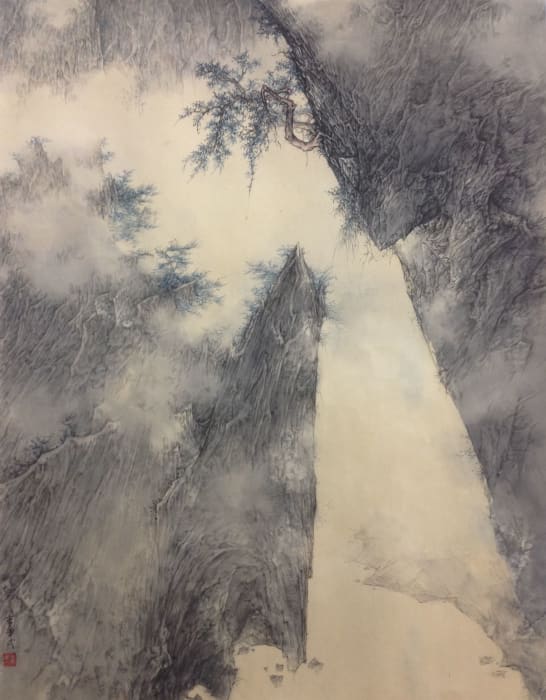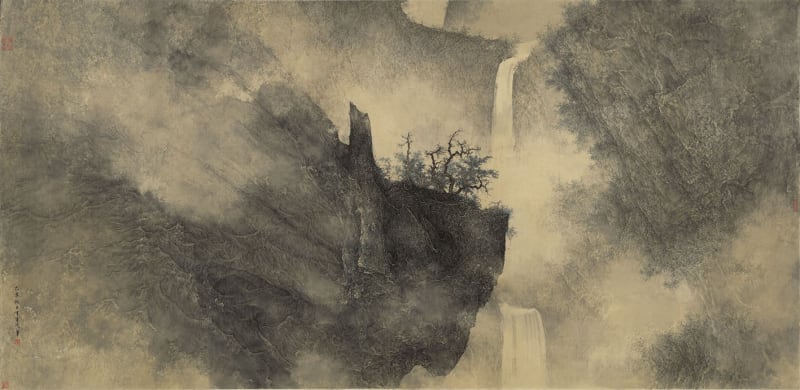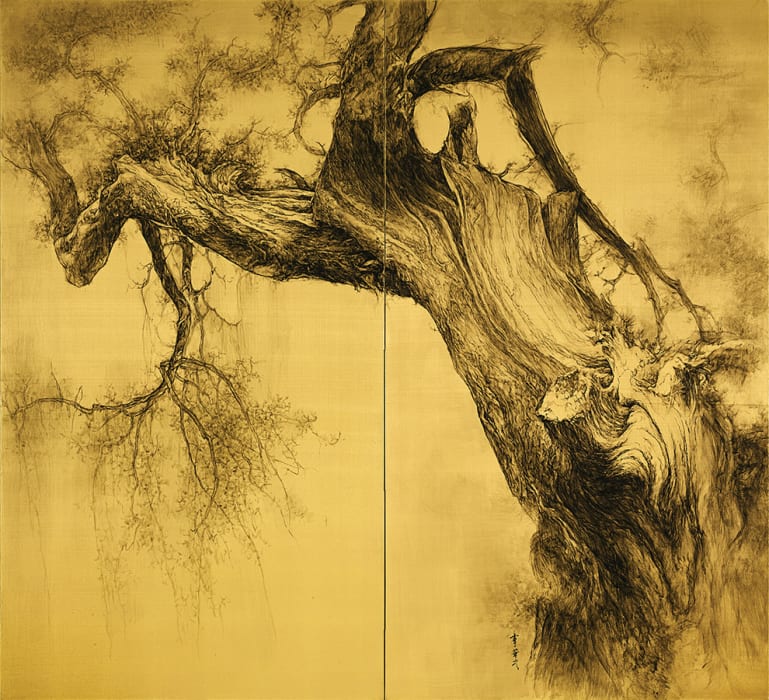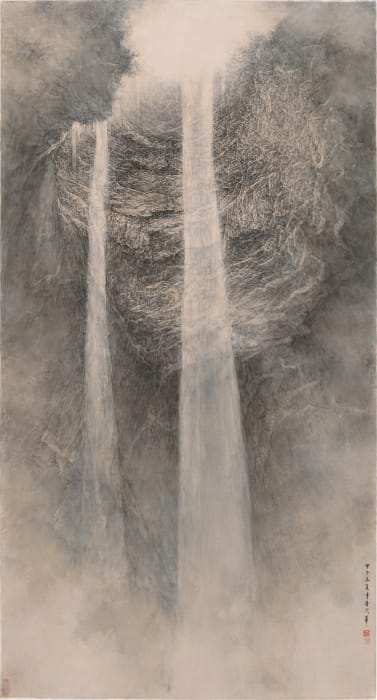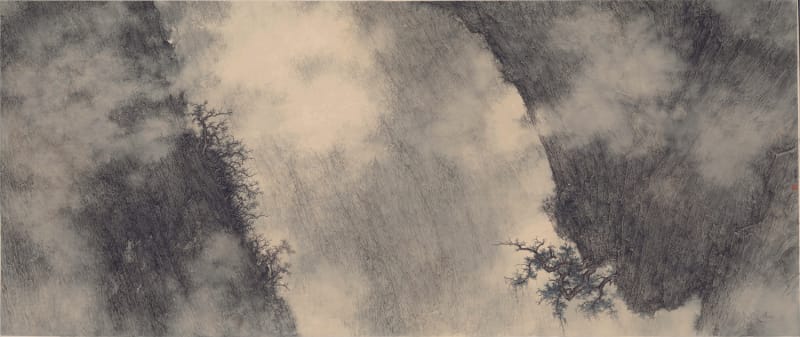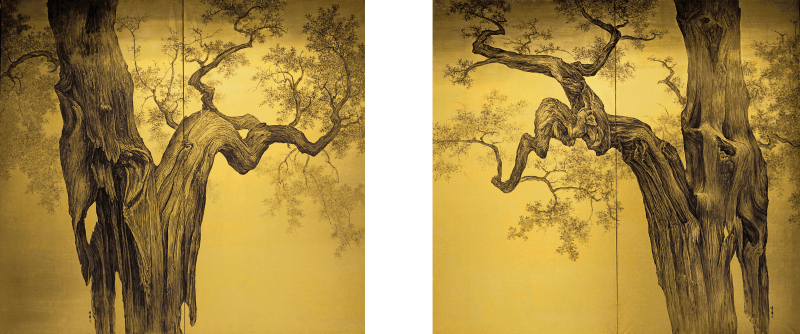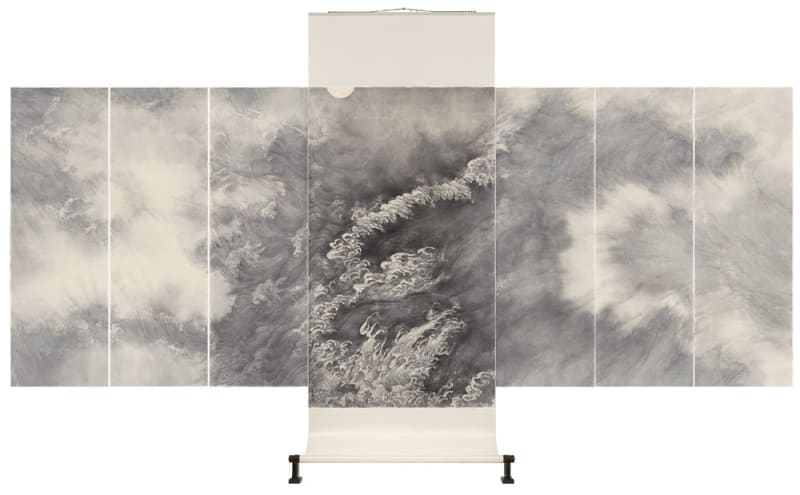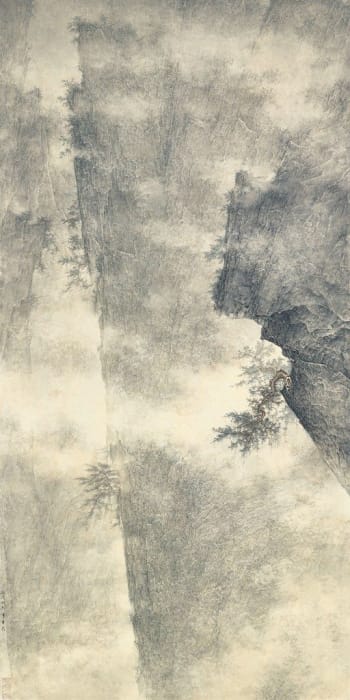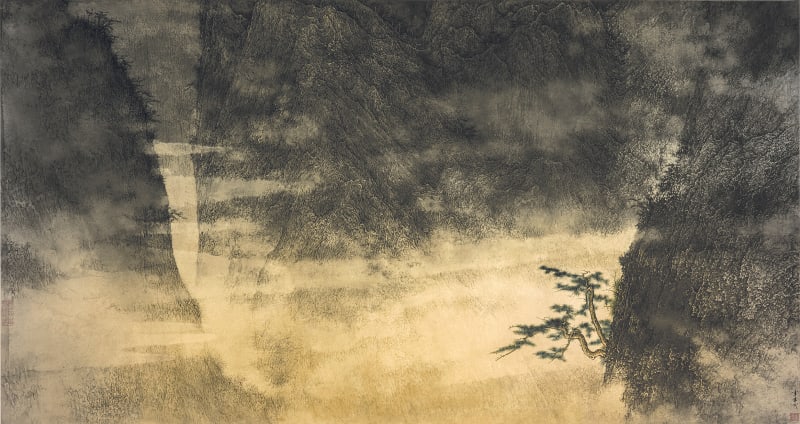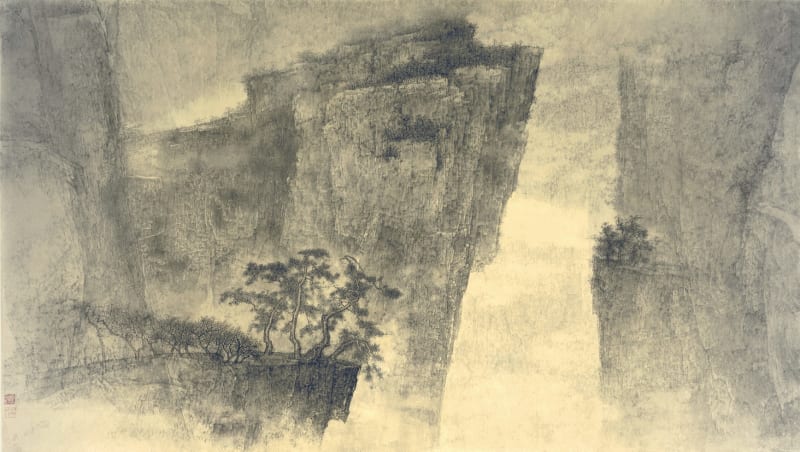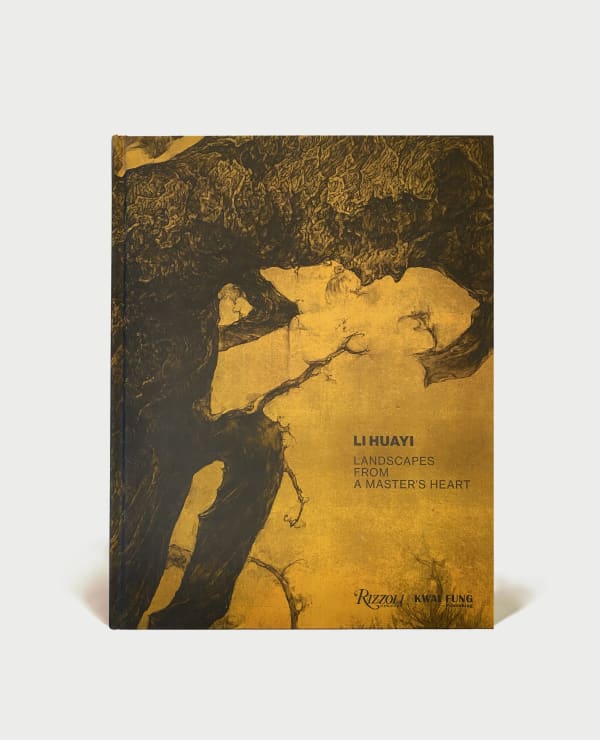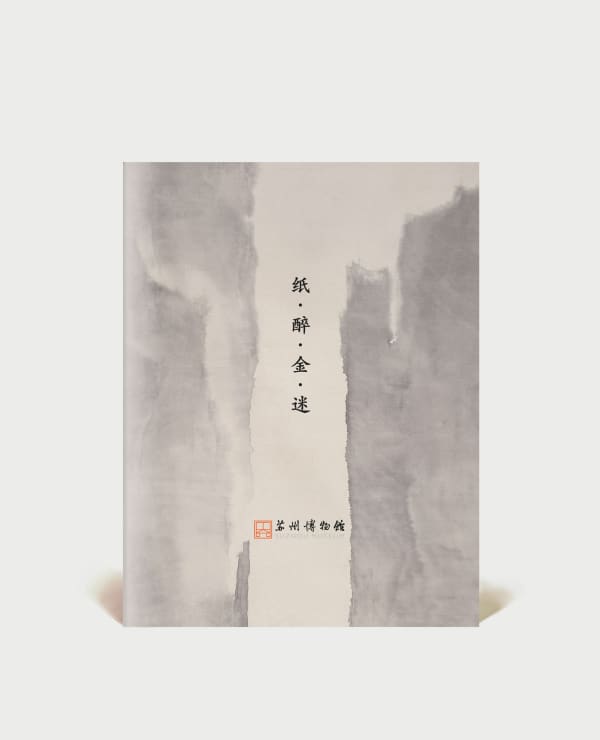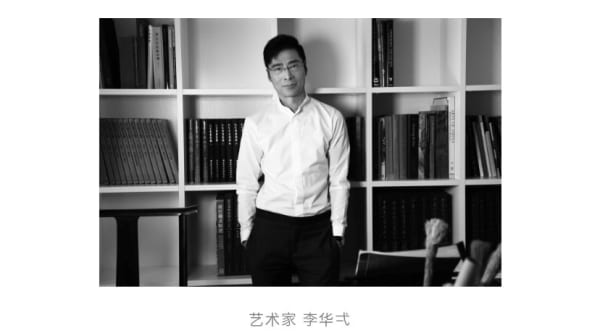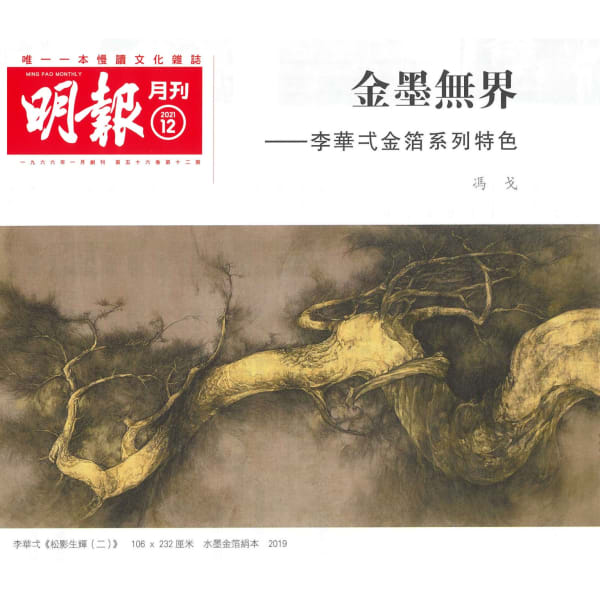Li Huayi 李華弌 b. 1948
Li Huayi was born in 1948 in Shanghai, China. When he was six years old, Li learned the art of traditional ink painting with Wang Jimei in private. By 1964, at the age of sixteen, Li began his studies in Western art with Zhang Chongren, who had studied at the Belgian Royal Academy in Brussels and who was known for his realistic watercolors. During the Cultural Revolution (1966-1976), Li was exempted from being sent to the countryside and allowed to remain in Shanghai to paint Soviet-style propaganda murals as a result of his dexterity with brush and ink and his excellent training in Western art.
Since the late 1970s, Li Huayi visited a number of China's significant scenic, historic and cultural sites in the late 1970s. During this journey, Li visited the celebrated peaks of Huangshan in Anhui Province, which are often depicted in many of his paintings. In Gansu Province, Li taught himself the early history of Chinese painting and achieved an understanding of religious painting through informal study of the Buddhist cave temples at Dunhuang. Finally, in 1978, Li travelled to Beijing where he saw his first Northern Song landscape painting and first major exhibition of modern Western art; both of which left him with deep and lasting impressions.


Li Huayi in Dunhuang (left), and Huangshan (right)
In 1982, Li Huayi and his wife immigrated to San Francisco. There, he enrolled at San Francisco's Academy of Art University to study Western art and he completed his master's degree in 1984. In the same year, Li held his first one-man exhibition in America at the Pacific Asia Museum in Pasadena, featuring a combination of his Dunhuang-style paintings and his 'Abstract Expressionist' works. His abstract paintings particularly received critical acclaim from the leading scholar of Chinese painting, Michael Sullivan.


Li Huayi at his studio in San Francisco (left), and at his solo exhibition in 1984 (right)
In the decade to follow, Li Huayi explored the prospects and boundaries of abstract painting combined with elements from early Chinese art. He gradually created his signature style in the early 1990s, which features grand mountain compositions that recall the monumental landscapes of the Northern Song dynasty.
Throughout Li Huayi's artistic career, China's extraordinary landscape has been a primary source of artistic inspiration. Particularly during the 2000s, he made a number of pilgrimages to famous mountains in China including Huangshan Mountain in Anhui, Lushan in Jiangxi, Wuyishan in Fujian, Zhangjiajie in Hunan, and Huashan in Shanxi, as well as an exploration of Li Cheng's home territory in Shandong.


Today, Li continues to find inspiration in China's vast mountains and frequently journeys back to his homeland.
Li Huayi has held solo and group exhibitions worldwide at the Asian Art Museum of San Francisco, the Arthur M. Sackler Museum, the Princeton University Art Museum, the Wooster College Art Museum, the Museum of Fine Arts, Boston and the National Art Museum of China.
Li has also held important solo exhibitions at the National Art Museum of China, Beijing (2011), the Asian Art Museum of San Francisco (2004), and was part of the seminal China 5000 Years Exhibition at the Guggenheim Museum in New York, NY (1999).


Li at the Guggenheim Museum (left), and the Asian Art Museum in San Francisco (right)
His works are widely collected by prestigious museums including the British Museum, UK, the Asian Art Museum of San Francisco, USA, the Brooklyn Museum, New York, USA, the Cleveland Museum of Art, USA, the Honolulu Museum of Art, Hawaii, USA, the Harvard Art Museums, USA, the Art Institute of Chicago, USA, the Spencer Museum of Art, the University of Kansas, USA, Suzhou Museum, China, M+, Hong Kong and the Hong Kong Museum of Art.
Artist Website - lihuayiarts.com
Wikipedia Page - https://en.wikipedia.org/wiki/Li_Huayi
-
 Magnificent Hills and Pine《立松重嶺》, 2006
Magnificent Hills and Pine《立松重嶺》, 2006 -
 Forever Young《不老》, 2011
Forever Young《不老》, 2011 -
 In the Spirit of the Big Dipper 《北斗之虛》, 2014
In the Spirit of the Big Dipper 《北斗之虛》, 2014 -
 Landscape 《山水》, 2016
Landscape 《山水》, 2016 -
 Endless Life《生生不息》, 2017
Endless Life《生生不息》, 2017 -
 Wind Riding 《翔翥》, 2017
Wind Riding 《翔翥》, 2017 -
 Boundless Life 《生命無涯》, 2017
Boundless Life 《生命無涯》, 2017 -
 A Boundless World 《海闊天高》, 2017
A Boundless World 《海闊天高》, 2017 -
 An Uncompromising Heart 《毅心毅骨》, 2018
An Uncompromising Heart 《毅心毅骨》, 2018 -
 Episode of Clouds and Water 《雲水一章》, 2010
Episode of Clouds and Water 《雲水一章》, 2010 -
 Ripples of Gleam《漾清輝》, 2017
Ripples of Gleam《漾清輝》, 2017 -
 Zen of Winter《冬之禪》, 2019
Zen of Winter《冬之禪》, 2019 -
 Song of Pines and Falling Water《泉聲松籟》, 1999
Song of Pines and Falling Water《泉聲松籟》, 1999 -
 Landscape《山水》, 1999
Landscape《山水》, 1999 -
 Landscape《山水》, 2003
Landscape《山水》, 2003 -
 Antique-like Beauty Between Cliffs《崖間蒼古》, 2012
Antique-like Beauty Between Cliffs《崖間蒼古》, 2012 -
 Immortal Mountain – Passage to Pureland 《仙山-天景通》, 2013
Immortal Mountain – Passage to Pureland 《仙山-天景通》, 2013 -
 Immortal Mountain – Pureland Streams 《仙山-天景流》, 2014
Immortal Mountain – Pureland Streams 《仙山-天景流》, 2014 -
 Untitled 《無題》, 2014
Untitled 《無題》, 2014 -
 Untitled《無題》, 2015
Untitled《無題》, 2015 -
 Landscape 《山水》, 2015
Landscape 《山水》, 2015 -
 Untitled《無題》, 2015
Untitled《無題》, 2015 -
 Untitled《無題》, 2016
Untitled《無題》, 2016 -
 Landscape I 《山水 (一)》, 2018
Landscape I 《山水 (一)》, 2018 -
 A Vision from a Grand Cliff 《崖高心遠》, 2018
A Vision from a Grand Cliff 《崖高心遠》, 2018 -
 Landscape II《山水 (二)》, 2018
Landscape II《山水 (二)》, 2018 -
 In the Density of Mist 《煙鎖山巒》, 2018
In the Density of Mist 《煙鎖山巒》, 2018
CRITICAL PRAISE
… In 1982 Li Huayi and his wife took advantage of an opportunity to move to the United States and settled in San Francisco… (and) enter the Academy of Art in San Francisco where he completed his Master of Fine Arts degree in 1984… Fortunately, his teachers at the Academy of Art were fully versed in post-modernist theory and encouraged him to develop his own style using Chinese materials and techniques. Through this philosophical background he came to see that his artistic challenge was not limited to linking the Chinese with the contemporary West, but rather linking ancient Chinese with the contemporary, both in China and in the West…
... Li Huayi found inspiration in the monumental landscape tradition of the Northern Song dynasty (960-1126)... he made a conscious choice, not based on the limits of his abilities, but rather on an artistic, theoretical and philosophical foundation. First, he cites the pure visual appeal of these imposing landscapes. Guo Xi's Early Spring, a favorite of Li Huayi's, is one of the most complex and visually stunning Chinese paintings..."
[Li Huayi's] pursuit of this artist [Li Cheng (916-967)] has led him not only to read the available literature, but also to travel to Li Cheng's home town in modern Linzi, Qingzhou, Shandong. There he has studied the physical landscape, the pine trees, and the general environment. He has climbed areas far from the normal paths in order to get some sense of what the place might have been like during Li Cheng's lifetime. In his works he attempts to capture not only the technical aspects of Li Cheng's painting style, but also, as much as possible in contemporary times, the essence of what Li Cheng would have seen and experienced…
… In a true post-modernist fashion, Li Huayi finds the theoretical rationale for his works in a number of sources. He finds in Abstract Expressionism and in the works and writings of the twentieth-century Chinese master Zhang Daqian (himself undeniably influenced by Abstract Expressionism) the theoretical roots of the splashed-ink technique he employs to create the large-scale compositional elements of his landscapes. He also has sought and found a theoretical basis in much earlier Chinese writing…
- MICHAEL J. KNIGHT
Former Senior Curator of Chinese Art, Asian Art Museum, San Francisco
Excerpt from "Li Huayi, Past and Present", originally published in the catalogue of exhibition Mountain Landscapes by Li Huayi, UK: Eskenazi, 2007
… By turning to the monumental landscape paintings of the Northern Song period for inspiration and by using Song-style brushwork, Li Huayi makes a break with traditional Chinese ink painting, which seeks inspiration in the works of the Qing-dynasty followers of Dong Qichang (1555 -1636). In addition, going beyond the Northern Song style, Li pushes his mountains beyond the composition's top and bottom so that his paintings are close-ups rather than complete panoramic views…
Setting the background mountains on an angle and bringing the landscape elements to the painting's surface give the paintings added monumentality and dynamism. Just as simplifying the landscapes make them exceptionally direct and compelling. These characteristics inject a new and very modern feel into Li Huayi's paintings…
ALTHOUGH ACCOMPLISHED IN WESTERN STYLES, LI HAS ESPOUSED THE CLASSICAL CHINESE TRADITION WITH A PASSIONATE DESIRE TO RESCUE AND REVITALIZE IT, YET HE HAS CLEARLY DISTINGUISHED HIS WORK FORM TRADITIONAL INK PAINTING.
- ROBERT D. MOWRY
Curator of Harvard Art Museums
Excerpt from "Li Huayi: Recent Works", originally published in the catalogue of exhibition Trees, Rocks, Mist and Mountains by Li Huayi, UK: Eskenazi, 2010
… The lightness of the touches with the applied tip of the brush in nuances of gray and black, enhanced with pale hues, and the rendition of the tiny pine trees poised on the crest lines bear witness to the admiration that Li Huayi professes for the Northern Song masters of the 11th and 12th centuries - the landscape shares that ethereal quality of beautiful things remembered from a dream. Yet, looked at more carefully, neither this landscape nor the others resemble the art of the Song dynasty…
… While the landscapes are unquestionably Chinese in spirit, the composition, the finer detail, and the handling of light that has no precedent in China, define an entirely novel art…
- SOUREN MELIKIAN
Art Critic
Excerpt from "A Master's Ethereal Visions, Inspired by East and West",
originally published in the International Herald Tribune, 2 Nov 2007

Li Huayi in Hubei, 2015
… Among contemporary Chinese artists, the landscape painting of Li Huayi is extraordinary for its spiritual profundity, imaginative power, and technical virtuosity...
… The worlds created in Li Huayi's early paintings were stable and peaceful. He cut the cosmic order into fragments, which he reconstructed in unexpected ways. One could argue that his work was postmodern, in that it deconstructed the pre-existing structures of the world (and of the classical painting to which it refers). Li Huayi's works move us by persuading us that he depicts essential qualities of the cosmos, of which each painting gives us a fragmentary glimpse…
… His works may move us profoundly, but are not overly passionate. Their power lies in their possession of the qualities that are required of literati painting, that are informed by centuries of Chinese philosophy, and that stand outside time…
- SHEN KUIYI
Professor of Art History, Theory, and Criticism, University of California, San Diego, the United States
Excerpt from "The Wonders of Brush and Ink – The Art of Li Huayi", published in Li Huayi – Landscapes from a Master's Heart, Rizzoli & Kwai Fung Art Publishing, 2018
… LI HUAYI IS AN ARTIST WHO REAFFIRMS THE
ONGOING VALUE OF THE AGE-OLD TRADITIONS
OF CHINESE INK PAINTING, EVEN AS HE
INNOVATES WITHIN THE MEDIUM.
In many cases, people might respond to Li Huayi's work in the same way that viewers must have responded to a great painting in ancient times: with awe and admiration. Those craggy peaks, twisted trees, mists and clouds still make a deep impression on our imagination. They encourage the same meditations on eternity and transience, on the seen and not-seen, that we find in the classics of Chinese landscape painting.
Li Huayi's work engages with this question of what may be seen as timeless and universal in art. His paintings strive to step outside of time, or at least to minimize the effect it has on the way one engages with a work. Standing in front of monumental pictures such as Antique-like Beauty in the Cliffs (2012) or Wandering in the Mountains (2013), it's easy to forget whatever one knows about art history or context and be swept up by the sheer drama. One imagines standing at some place within the landscape, feeling dwarfed and overwhelmed by the spectacle of untrammeled nature.
- JOHN MCDONALD
Excerpt from "Li Huayi: Fantasies on Paper and Enchantments in Gold", article from YISHU: Journal of Contemporary Chinese Art, Volume 17, Number 3, Taipei, Taiwan: May/June 2018.
… The art of Li Huayi is pursuing development through the heritage of the past, rather than singularly focused on looking for a change...
… The art of Li Huayi obviously deviates from the literati painting system developed since the Yuan Dynasty. Instead, he strives to re-connect with the Song Dynasty tradition, to capture accurately the essence of nature with his ink and brush. He is effectively infusing his paintings with his emotions and spirit. In other words, he strives to inherit another stream of Chinese artistic tradition, tracing back to an even older concept of Chinese painting, which precedes the development of the logical principles of literati painting. He is exploring not only the spirit of this ancient painting tradition, but also its belief in meticulousness as the standard for conducting every aspect of life, including art creation and even daily life details…
... the very monumentality of his works is created by his weaving together innumerable layers of delicacy. In my understanding, the construction of imagery in this manner is borne from Li's ingenuity, rather than scrupulousness. He paints his mountains and water as if they were real mountains and water; it is an artistic realm in its own right...
- WU HONGLIANG
Vice President of Beijing Fine Art Academy
Excerpt from "From the Magic of Nature – A Study of the Art of Li Huayi, by way of Answering Several Questions" originally published in the catalogue of exhibition Exotica- Latest Works of Li Huayi Hong Kong: Kwai Fung Art Publishing, 2016
-
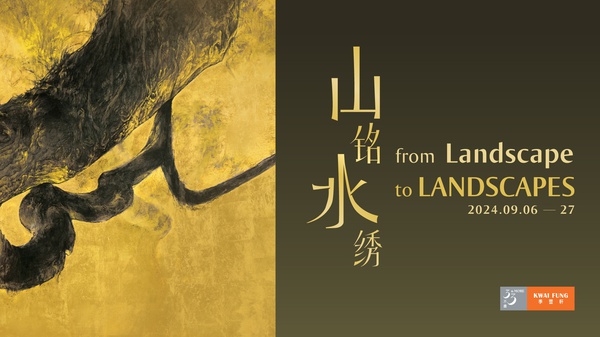
From Landscape to Landscapes
Alliance Française de Singapour 6 - 27 Sep 2024Kwai Fung Hin is pleased to announce its debut exhibition in Singapore, From Landscape to Landscapes, a group exhibition that brings together works by artists...Read more -

Infinities between Ink and Gold - Recent Works of Li Huayi
F Hall, Tai Kwun 25 Nov - 12 Dec 2021Read more -

The Cornerstone
An Exhibition Celebrating the 30th Anniversary of Kwai Fung 14 Jun - 31 Aug 2021Read more -

Law of Nature, Tao of Man - Exhibition of Li Huayi
Kwai Fung Hin Art Gallery, G/F, 20 Ice House Street, Central, Hong Kong 13 Nov - 14 Dec 2019Read more -

Fantasies on Paper and Enchantments in Gold - Solo Exhibition of Li Huayi
Suzhou Museum 27 Sep - 17 Dec 2017From September 27 - December 17, 2017, Li Huayi's solo exhibition "Fantasies on Paper and Enchantments in Gold" will be shown at the New Suzhou Museum.Read more -

Landscapes in New Dimension - Solo Exhibition of Li Huayi
Kwai Fung Hin Art Gallery, G/F, 20 Ice House Street, Central, Hong Kong 21 Mar - 21 Apr 2017Read more -

Exotica - Latest Works of Li Huayi
Kwai Fung Hin Art Gallery, G/F, 20 Ice House Street, Central, Hong Kong 22 Mar - 21 May 2016Recent works of renowned contemporary ink artist Li HuayiRead more
-

Booth C01丨KWAI FUNG HIN AT TOKYO GENDAI 2024
4 - 7 Jul 2024Kwai Fung Hin Art Gallery is thrilled to announce its debut at Tokyo Gendai art fair this year. The gallery will showcase a diverse and...Read more -

Booth H6 | Ink Asia 2023
4 - 8 Oct 2023Kwai Fung Hin Art Gallery is delighted to announce its participation in Ink Asia 2023 . The gallery will present an exquisitely curated collection featuring...Read more -

Booth BI06 丨 Art SG 2023
11 - 15 Jan 2023Kwai Fung Hin Art Gallery's presentation at ART SG unites eight preeminent artists, Ziad Dalloul, Piero Dorazio, Li Huayi, Lalan, Georges Mathieu, Nicolas Party, Xue Song and Jonas Wood.Read more -
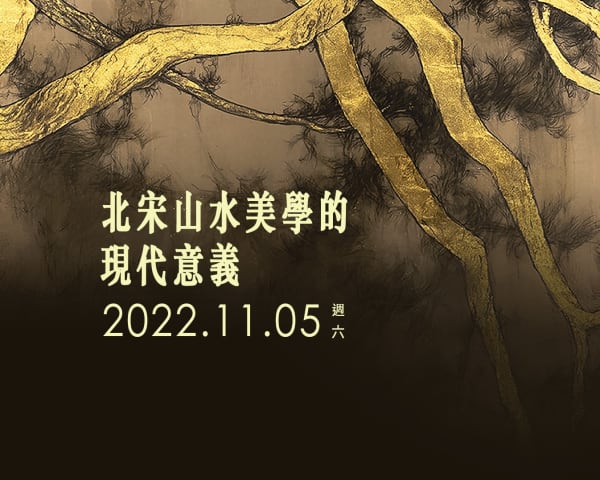
Aesthetics in Northern Song Landscape Painting and Its Modern Implications
5 Nov 2022Chinese landscape painting had fully matured by the Northern Song Dynasty, with great masters emerging during this era. Their works convey the elegance and cultivation...Read more -
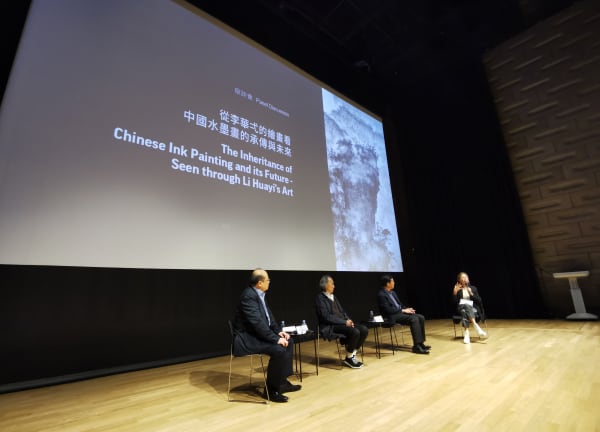
The Inheritance of Chinese Ink Painting and its Future - Seen through Li Huayi's Art
JC Cube Tai Kwun 5 Dec 2021Read more
-
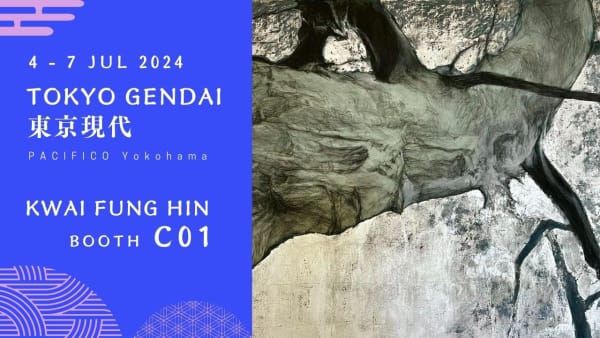
Booth C01丨KWAI FUNG HIN AT TOKYO GENDAI 2024
4 - 7 Jul 2024Kwai Fung Hin Art Gallery is thrilled to announce its debut at Tokyo Gendai art fair this year. The gallery will showcase a diverse and...Read more -
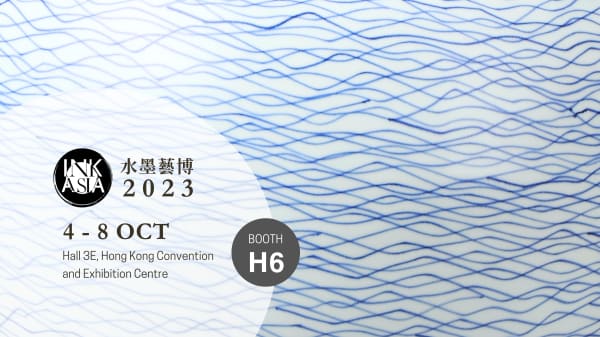
Booth H6 | Ink Asia 2023
4 - 8 Oct 2023Kwai Fung Hin Art Gallery is delighted to announce its participation in Ink Asia 2023 . The gallery will present an exquisitely curated collection featuring...Read more -

Booth D13 丨 Taipei Dangdai Art & Ideas 2023
11 - 14 May 2023Kwai Fung Hin Art Gallery is delighted to participate in the Taipei Dangdai Art & Ideas for the first time, with a curation of important artworks from gallery's represented artists, demonstrating extensive cultural experiences and global perspectives, which bridge the West and the East in fresh and remarkable ways.Read more -

Booth 3E03 丨 ART BASEL HONG KONG 2023
21 - 25 Mar 2023Kwai Fung Hin is delighted to participate in the 2023 edition of Art Basel Hong Kong with a selection of important works by modern and contemporary artists.Read more -

Booth BI06 丨 Art SG 2023
11 - 15 Jan 2023Kwai Fung Hin Art Gallery's presentation at ART SG unites eight preeminent artists, Ziad Dalloul, Piero Dorazio, Li Huayi, Lalan, Georges Mathieu, Nicolas Party, Xue Song and Jonas Wood.Read more -

Booth 1B26丨Art Basel Hong Kong 2022
25 - 29 May 2022Read more -
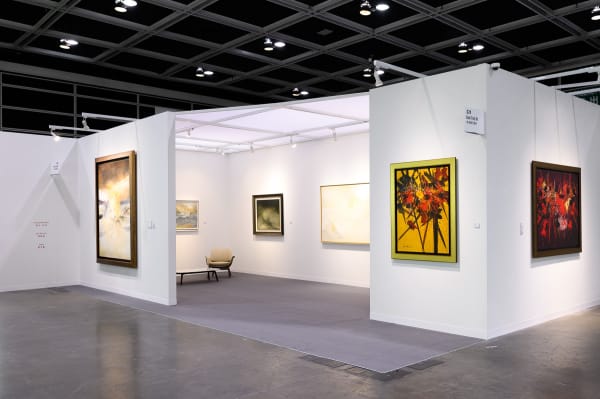
Booth C2 & S24 | Fine Art Asia 2020 & Hong Kong Spotlight by Art Basel
27 - 30 Nov 2020Kwai Fung Hin Art Gallery is delighted to announce our participation in both Fine Art Asia 2020 and Hong Kong Spotlight by Art Basel.Read more -
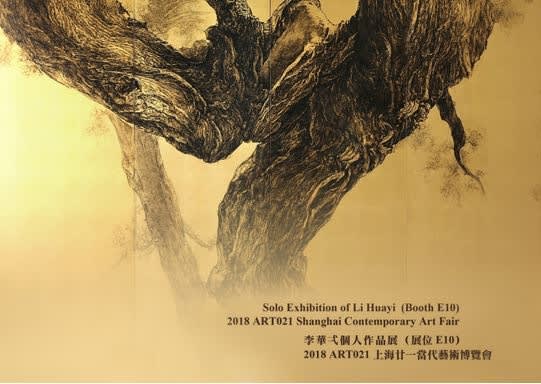
Art021 Shanghai Contemporary Art Fair - Solo Exhibition of Li Huayi
8 - 11 Nov 2018Kwai Fung Hin Art Gallery proudly presents the solo exhibition of Master contemporary ink painter Li Huayi at Booth E10 at Art021 Shanghai Contemporary Art...Read more -

Art Basel Hong Kong 2017 - Solo Exhibition of Li Huayi
23 - 25 Mar 2017Kwai Fung Hin Art Gallery proudly presents the solo exhibition of Li Huayi at Booth 3D46 at the Insights sector in Art Basel Hong Kong...Read more



